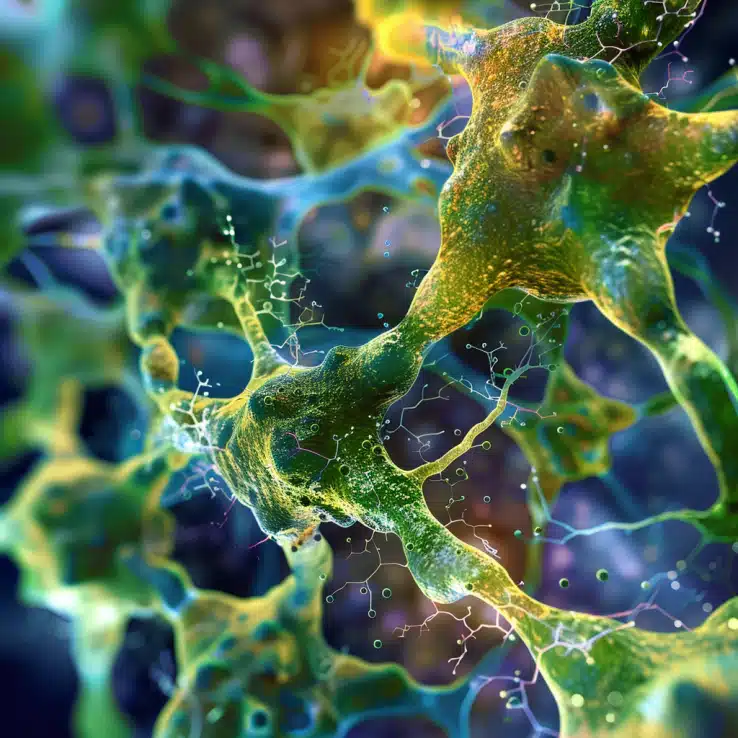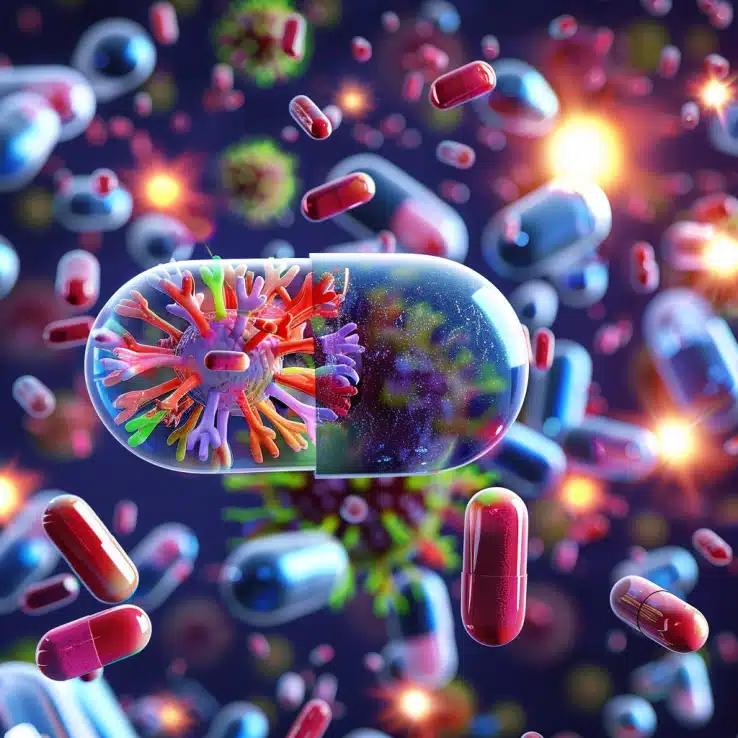TLDR: Quercetin-based alginate nanogels loaded with brain-derived neurotrophic factor (BDNF) can effectively cross the blood-brain barrier via intranasal delivery, providing a promising treatment for depressive disorders.
Highlights:
- Nanogels: Quercetin nanogels protect BDNF from oxidative damage, exhibit rapid brain distribution, and significantly enhance bioavailability compared to oral administration.
- Efficacy: BDNF-Quercetin nanogels delivered via intranasal route show significant antidepressant effects in stress-induced animal models, including reversal of despair behavior and alleviation of weight loss and anhedonia in rats.
- Mechanisms: The antidepressant effects are associated with the regulation of the glutamatergic system, PI3K-Akt, and BDNF-TrkB signaling pathways, crucial for neuronal function and plasticity.
- Sustained Release: These nanogels in a thermosensitive gel achieve sustained and controlled release of BDNF, ensuring prolonged therapeutic effects.
- Bioavailability: Intranasal delivery of these nanogels provides nearly 50-fold increased bioavailability of quercetin compared to oral administration, making it a highly efficient delivery method.
Source: Journal of Nanobiotechnology (2023)
Why use Quercetin nanogels loaded with BDNF?
Quercetin nanogels loaded with brain-derived neurotrophic factor (BDNF) were designed to address two primary challenges in the treatment of depressive disorders:
- Blood-Brain Barrier (BBB) Permeability: Large protein molecules like BDNF cannot efficiently cross the BBB, limiting their therapeutic potential when administered through conventional routes.
- Oxidative Damage: BDNF is susceptible to oxidative damage in vivo, which can degrade its efficacy and stability.
To overcome these challenges, the following design features were incorporated:
- Nanogel Composition: Quercetin, a natural antioxidant with known neuroprotective and antidepressant effects, was used to form alginate-based nanogels. This composition not only protects BDNF from oxidative damage but also enhances its stability and efficacy.
- Intranasal Delivery Route: The nanogels were designed for intranasal administration, enabling them to bypass the BBB via the nose-to-brain pathway. This non-invasive delivery method ensures rapid and efficient transport of BDNF to the brain.
- Thermosensitive Gel: The nanogels were incorporated into a thermosensitive gel, allowing for sustained and controlled release of BDNF and quercetin, further enhancing their therapeutic effects.
Quercetin Nanogels with BDNF to Treat Depression (Mechanisms of Action)

The quercetin nanogels loaded with BDNF treat depression through multiple interconnected mechanisms:
Neurotrophic Support
BDNF Function: BDNF is crucial for synaptic plasticity, neuronal survival, and differentiation. It enhances the resilience of neurons to stress and promotes neurogenesis, which are often impaired in depressive disorders.
Protection by Quercetin: Quercetin protects BDNF from oxidative damage, ensuring its stability and prolonged action within the brain.
Antioxidant & Anti-Inflammatory Effects
Quercetin’s Role: As a potent antioxidant, quercetin reduces oxidative stress and inflammation, both of which are linked to the pathophysiology of depression.
Reduction of Inflammatory Markers: The nanogels have been shown to decrease levels of pro-inflammatory cytokines like TNF-α and IL-6, which are elevated in depressed individuals.
Glutamatergic System Modulation
Regulation by BDNF: BDNF modulates the glutamatergic system, which is involved in synaptic transmission and plasticity. Dysregulation of this system is associated with depressive symptoms.
Nanogels’ Impact: By restoring proper function to the glutamatergic pathways, the nanogels help alleviate depressive symptoms.
PI3K-Akt Signaling Pathway
Activation by BDNF: BDNF activates the PI3K-Akt pathway, which plays a key role in cell survival and neuroplasticity.
Enhanced Signaling: The sustained release of BDNF from the nanogels ensures continuous activation of this pathway, promoting neuronal health and function.
BDNF-TrkB Signaling
TrkB Receptor Activation: BDNF binds to its receptor, TrkB, initiating signaling cascades that support neuronal growth and plasticity.
Improved Synaptic Plasticity: The activation of BDNF-TrkB signaling by the nanogels enhances synaptic plasticity, which is often compromised in depression.
Quercetin Nanogels Loaded with BDNF for Treating Depression (2023 Research)

1. Nanogel Characterization & Properties
Uniform Size and Stability: The quercetin nanogels exhibited a uniform size distribution with a particle size of approximately 76.34 ± 2.34 nm. They demonstrated excellent stability and biocompatibility, crucial for therapeutic applications.
Antioxidant Capabilities: Quercetin nanogels showed significant antioxidant activities, protecting BDNF from oxidative damage, which is essential for maintaining the protein’s therapeutic potential.
2. Enhanced Bioavailability
Intranasal Delivery Advantage: Intranasal administration of quercetin nanogels resulted in rapid brain distribution and significantly higher bioavailability compared to oral quercetin. The bioavailability of quercetin was nearly 50-fold higher when delivered intranasally.
Sustained and Controlled Release: Quercetin nanogels in the thermosensitive gel achieved a sustained and controlled release of BDNF, facilitating continuous therapeutic effects over time.
3. Therapeutic Efficacy in Animal Models
Antidepressant Effects in Stress-Induced Models: BDNF-quercetin nanogels demonstrated significant antidepressant effects in animal models:
- Reserpine-Induced Rats: These nanogels alleviated reserpine-induced depression by preventing the depletion of monoamine neurotransmitters like 5-HT, NE, and DA.
- Behavioral Tests: In the tail suspension test (TST) and forced swimming test (FST), the nanogels significantly reduced immobility duration, indicating improved depressive behavior.
4. Mechanisms of Action
Neurotrophic Support: BDNF-quercetin nanogels facilitated the delivery of BDNF to the brain, promoting synaptic plasticity, neuronal survival, and differentiation.
Regulation of Glutamatergic System: The nanogels modulated the glutamatergic system, which is crucial for synaptic transmission and plasticity, thereby alleviating depressive symptoms.
PI3K-Akt Pathway Activation: By activating the PI3K-Akt signaling pathway, the nanogels supported cell survival and neuroplasticity, contributing to their antidepressant effects.
BDNF-TrkB Signaling: Activation of the BDNF-TrkB signaling pathway by the nanogels enhanced synaptic plasticity and neuronal health.
5. Impact on Inflammatory Markers
Anti-Inflammatory Effects: The nanogels significantly reduced levels of pro-inflammatory cytokines such as TNF-α and IL-6, which are often elevated in individuals with depression.
Reduction of COX-2 and PGE2: The nanogels inhibited the expression of COX-2 and its downstream product PGE2, further contributing to their anti-inflammatory properties.
6. Omics Analysis and Protein Expression
Transcriptomic Findings: RNA sequencing revealed that BDNF-quercetin nanogels upregulated genes related to biological processes such as peptidyl-histidine modification and positive regulation of glutamate receptor activity. KEGG pathway analysis highlighted the involvement of the TGF-β and PI3K-Akt signaling pathways.
Metabolomic Analysis: The nanogels influenced several metabolic pathways, including biotin metabolism, citrate cycle, tryptophan metabolism, and alanine, aspartate, and glutamate metabolism.
Western Blot Verification: Protein expression analysis confirmed that the nanogels regulated key proteins involved in the glutamatergic system and PI3K-Akt signaling pathway, such as GRIA3, GRIN2B, BDNF, TrkB, GSK3β, and p-mTOR.
7. Behavioral and Biochemical Improvements in Rats
Behavioral Improvements: In the chronic unpredictable mild stress (CUMS) model, the nanogels alleviated weight loss and anhedonia, indicating their potent antidepressant effects.
Biochemical Indicators: The nanogels improved biochemical indicators such as BDNF levels in plasma and hippocampus, reduced IL-6 and PGE2 levels, and regulated the HPA axis function by normalizing the levels of CRH, ACTH, corticosterone, and testosterone.
Limitations of the research…
- Translational Gaps: While the results in animal models are promising, the translation of these findings to human subjects requires further investigation.
- Delivery Challenges: Ensuring consistent and efficient intranasal delivery in humans might pose technical and compliance challenges.
- Long-Term Effects: The long-term safety and efficacy of repeated intranasal administration of quercetin nanogels need thorough evaluation.
- Biological Variability: Individual variability in response to treatment and potential side effects were not fully addressed in this study.
Potential Applications and Human Trials
The findings suggest that quercetin nanogels loaded with BDNF could become a novel therapeutic strategy for depressive disorders, offering advantages such as non-invasive delivery, enhanced bioavailability, and potent antidepressant effects.
Given the promising preclinical results, the next steps would involve:
- Human Trials: Phase I clinical trials to assess safety, tolerability, and preliminary efficacy in humans. These trials could potentially start within 1-2 years, pending regulatory approval and further preclinical studies.
- Broader Applications: Beyond depression, this nanogel delivery system could be adapted for other neurological conditions requiring targeted brain delivery of therapeutic proteins.
Conclusion: Quercetin Alginate Nanogels with BDNF for Depression
This study successfully developed quercetin-based alginate nanogels loaded with BDNF, demonstrating their potential as an effective treatment for depressive disorders.
The nanogels showed significant antidepressant effects in animal models by enhancing BDNF stability and bioavailability, protecting against oxidative damage, and modulating key signaling pathways.
Intranasal delivery proved to be a promising route, offering rapid brain distribution and sustained release of the therapeutic agents.
While these findings are promising, further research is needed to translate these results into clinical applications, including human trials to ensure safety and efficacy.
If successful, this innovative approach could revolutionize the treatment of depression and other neurological disorders, providing a non-invasive, efficient, and potent therapeutic option.
The study showcases the importance of integrating nanotechnology and neuroscience to develop advanced treatment strategies for complex mental health conditions.
References
- Study: Enhanced antidepressant effects of BDNF-quercetin alginate nanogels for depression therapy (2024)
- Authors: Dong Xu et al.







